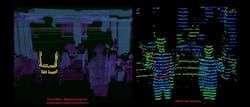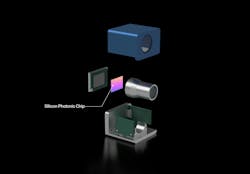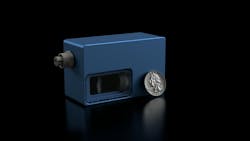The battle of LiDAR sensor technologies: FMCW vs. ToF
Frequency-modulated continuous-wave (FMCW) LiDAR operates differently than traditional time-of-flight (ToF) systems. While ToF LiDAR measures the time it takes for a light pulse to travel to an object and return, FMCW LiDAR analyzes the frequency shift of light waves reflected from the object. This results in several significant advantages, particularly in terms of accuracy and resolution.
A key benefit of FMCW LiDAR is its ability to handle higher optical power without compromising signal integrity. ToF systems, especially ones using semiconductor chips, tend to struggle with high-power light bursts. Their optical paths are often ‘leaky”—excessive power can lead to signal loss, particularly when light needs to travel long distances or reflect off bright objects—and can make ToF systems unreliable for real-world conditions.
On the other hand, FMCW LiDAR can sustain higher peak powers while maintaining measurement accuracy, which makes it ideal for applications that demand precision like factory automation and autonomous driving. FMCW LiDAR has demonstrated superior performance within these challenging environments, and offers greater consistency and reliability compared to ToF systems.
ToF problems: Blooming and range limitations
While ToF LiDAR is valued for its simplicity and reliability, it faces several critical issues. One of the most significant is “blooming,” which occurs when a LiDAR sensor receives an overwhelming reflection from a bright object. This happens with traffic signs, safety vests, or high reflective surfaces, and causes blur and false positive points all around that bright object. Blooming is particularly problematic on construction sites or within busy urban areas.
To counteract blooming, LiDAR systems use filters to remove false positive points, but this filtering can introduce its own set of challenges. Filtering out bright reflections can result in missed detections of objects adjacent to them—such as a pedestrian near a reflective traffic cone—and this is a major concern for autonomous driving safety.
Beyond blooming, ToF systems also face range limitations. LiDAR systems using technologies like vertical-cavity surface-emitting lasers (VCSELs) and single-photon avalanche diodes (SPADs) are restricted in the amount of power they can emit due to eye safety regulations and energy constraints. Increasing the power to extend their range only exacerbates the blooming problem—which creates a paradox because improving range reduces accuracy. Autonomous vehicles demand both long-range capability and high precision, so these limitations make ToF less suitable for next-generation sensor systems.
What makes FMCW LiDAR more affordable?
Cost is one of the biggest obstacles to LiDAR adoption, especially for the automotive industry and others where mass-market deployment is crucial. Traditional LiDAR sensors are expensive, which limits their use to premium applications and prototyping. To scale autonomous vehicles and other applications, the cost of LiDAR systems must drop significantly.
This is where FMCW LiDAR shines (see Fig. 1). While FMCW systems generally require more components than ToF, they offer a greater potential for integration by reducing manufacturing complexity and cost. FMCW LiDAR can be integrated into a single chip or system-on-chip (SoC) design, which significantly lowers production costs (see Figs. 2 and 3). By reducing the number of discrete components, FMCW systems become easier and cheaper to mass-produce—and it makes them more cost-effective for large-scale applications within sectors like automotive, robotics, and industrial automation.
By contrast, ToF systems require discrete components, which leads to higher manufacturing costs and complexities that make mass production less viable. While FMCW LiDAR’s performance advantages are clear, the challenge remains to scale up production to meet the demands of various industries.
FMCW LiDAR gains momentum
FMCW LiDAR is gaining significant traction across various industries—particularly in robotics. Original equipment manufacturers (OEM) and Tier-1 suppliers are increasingly exploring FMCW solutions, with widespread adoption expected within the next few years.
One of the key reasons FMCW LiDAR is gaining popularity is its ability to perform consistently within a wide range of environmental conditions. Unlike ToF systems, which can struggle with bright sunlight or low-light environments, FMCW LiDAR excels within diverse lighting conditions. This makes it especially valuable for autonomous driving applications, where sensors need to operate reliably from bright daylight to complete darkness.
Beyond automotive use, FMCW LiDAR’s ability to offer high precision over long ranges without suffering from blooming makes it an attractive solution for industrial automation, robotics, and mapping applications. Its performance within complex, dynamic environments positions it as the go-to technology for industries requiring advanced three-dimensional (3D) sensing.
Path to mainstream adoption
Despite its advantages, FMCW LiDAR is still evolving and its widespread adoption will take time. The technology is more complex than ToF, which makes producing it at scale while maintaining affordability a significant challenge. But as integrated small-scale solutions become more feasible, the cost of FMCW systems should decrease. Mass production on semiconductor chips could also help lower costs, improve reliability, and increase scalability.
This would help position FMCW LiDAR as the dominant technology for industries ranging from autonomous driving to robotics—and further innovation will accelerate its adoption.
Affordable FMCW LiDAR
Voyant has created affordable FMCW LiDAR technology, with its CARBON LiDAR system (see Fig. 4). It’s an ultralow-cost FMCW four-dimensional (4D) LiDAR designed to bring high-performance 3D sensing to a wide range of industries and budgets. It features LiDAR-on-chip technology—a highly integrated silicon photonic chip that combines thousands of optical and electrical components, including on-chip beam steering, into a compact, fingernail-sized module.
The system’s compact size and powerful capabilities deliver instant velocity measurements at every pixel and exceptional accuracy, which makes it ideal for real-time object detection. Its low cost ($1,490 for single-unit applications) promises to democratize access to cutting-edge LiDAR technology.
Voyant is accepting orders for CARBON, with shipments expected to begin in February 2025. It’s poised to revolutionize industries that have been waiting for affordable, high-performance LiDAR technology—and will further push FMCW into the mainstream.
Will FMCW LiDAR overtake ToF LiDAR?
The battle between FMCW and ToF LiDAR is intensifying and, while ToF has been the dominant technology, FMCW is emerging as the superior solution for many high-demand applications. Its ability to handle higher optical power, overcome blooming issues, and provide cost-effective integration make it the technology of choice for next-generation LiDAR systems. As production scales and prices drop, FMCW LiDAR is poised to revolutionize industries from autonomous driving to robotics—and offers new possibilities for innovation in sensor technology.
Developments like Voyant’s CARBON, are making FMCW LiDAR increasingly accessible and affordable, and are accelerating its path to mass adoption. As the technology continues to mature, FMCW LiDAR will undoubtedly play a key role in shaping the future of advanced sensing solutions.
About the Author
Clement Kong
Clement Kong is the vice president of Voyant Photonics.



